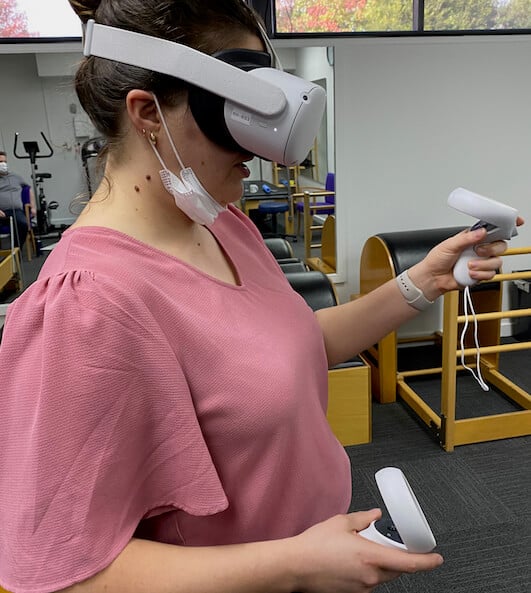From a culmination of years of research and clinical practice, the Fit For Purpose model is emerging as arguably the most logical, research-based method of helping people with low back pain.
‘Fit For Purpose’ can mean fit for play, fit for performance, fit for competing, fit for sitting … whatever.
Fit for tasks of daily living.
It was born from asking the question ‘what has gone wrong in people with persistent pain’, and addressing each of these key areas using the understanding of these pathologies.
This approach to helping persistent low back pain that was tested in the RESOLVE trial, published in late 2022.
In the person with persistent or chronic pain, it has been established that there are three aspects, called ‘pillars’ that do not function normally.
The problem of chronic or persistent pain is proposed to occur when the patient 1. has a belief the body isn’t fit for purpose, 2. doesn’t feel fit for purpose and 3. physically isn’t fit for purpose.
Treatment using the Fit For Purpose Model targets each of these, one at a time and sequentially, but sometimes all at the same time.
Pillar 1. Changing the belief that your body is actually fit for purpose
Most people with musculoskeletal pain believe understandably that the painful body part is not fit for what you want it to do.
Perhaps they believe that it is weak, not moving well, out of alignment, fragile, vulnerable, unstable, or the movement strategy is wrong.
Sometimes these convictions have been reinforced to them by well-meaning health professionals.
The belief might be something that they consciously are aware of and articulate.
The belief will also be held non-consciously where the protective systems are operating as if the back is fragile, because that is the brain and body’s judgement of the situation.
This pillar is addressed using modern pain neuroscience education, where the aim is to help the patient reconceptulaise their pain ie look at their pain different, through a different lens with correct information.
That is, the aim is to help the patient to understand how pain works better, why their pain behaves the way it does, and in the process hopefully make it less threatening.
Getting this shift in understanding is thought to be even more important than ever. And we always knew it was important!
You can get a sense of these updated messages on our page about pain science nuggets.
Pillar 2. Changing the way you ‘feel’ your body
Through a lot of research findings over the last 25 or so years, it has been shown that the ‘maps of the body’ held within the brain are different in someone with persistent pain. They are not the same as in people that are painfree.
This affects how your brain and your body communicate with each other, and how you feel about the body part in question.
It makes the ‘maps’ less precise, with pain more easily triggered and less easy to ‘switch off’.
This results in spreading pain, increased sensitivity and difficulty with the pain experience being moderated when it isn’t required.
It affects accuracy of movement and accuracy of the sensation of touch.
This pillar is addressed using graded motor imagery, which is a group of exercises and techniques to help the way the brain ‘sees’ the body part become more accurate.
This will help with accuracy of movement and accuracy of the incoming sensory information too.
In essence, it improves the messaging between the brain to the body, and the body to the brain
Pillar 3. Making your body physically fit for purpose
This is the part of the model that physios are most familiar with.
It is about helping people to get stronger and move better, and improving the structural integrity and the capacity of a body part.
It takes a more conventional approach to increasing physical capacity of the body to create change.
It uses overload principles and the idea of the ‘sweet zone for change’ . The body will change if we get the loading and the exposure right.
This is also done in a graded fashion, using movement, strengthening and general exercise.
This needs to be done in a way that is gradually more challenging and loading but done in a way that still feels ‘safe’.
Virtual Reality and the Fit For Purpose Model
The advent of virtual reality and its accessibility has made it an obvious way of delivering this kind of intervention.
The immersive experience of virtual reality provides another way of delivering Pillar 1, which is learning about pain. Using virtual reality, the messages of pain neuroscience can be delivered audiovisually and more experientially. These experiences with virtual reality then provide a conversation-starter between the therapist and the patient.
An obvious benefit of virtual reality is with Pillar 2, which is the brain ‘map’ improvement of the back and helping it to ‘feel fit for purpose’.
The benefit of Pillar 3 with virtual reality is doing exercise that improves endurance and range of movement in what seems like foreign environment and therefore in a completely different context. It allows the person to move in ways that they would normally find painful, exploiting the visual input to ‘uncouple’ the usual protective response to movement.
Reality Health have developed a virtual reality platform in collaboration with Prof Lorimer Moseley specifically for the purpose of helping persistent pain. Prof Moseley was a co-author in the RESOLVE trial and co-creator of the Fit For Purpose Model. You can hear him talking about the model below.

Do the pillars needs to be addressed in sequence?
These are described in a sequence for a reason.
For example, it is hard to go through the activities of pillar 2 which involve brain retraining, if there is no understanding of how the brain is involved. Or that there are maps held in the brain of the painful back.
However, these pillars can be addressed concurrently, and there can be overlap as long as it is reasoned.
For example, the strengthening of a back using an exercise like deadlifts should be done with reassurance of pain education snippets, and elements of brain retraining by using mirror feedback.
If an exercise evokes some pain, the pain neuroscience education of Pillar One is important to understand why it hurts and to reassure the patient about when it is OK.
Summary of the Fit For Purpose Model
The abstract of the article on the Fit For Purpose Model* states the concept beautifully:
‘This model holds the view that ‘chonic non-specific low back pain represents a state in which the person in pain holds strong and relatively intransient internal models of an immutably damaged, fragile and unhealthy back , and information that supports these models is more available and more trustworthy than information that counters them.’
In other words, the person holds the belief deep in their gut, both consciously and non-consciously, that their back is in trouble and not up to the task, and everything they see and hear and think backs this idea up.
Then the purpose of the Fit For Purpose Model is to shift this conscious and non-conscious view towards the back being strong, capable, adaptable and fit for purpose, and therefore reduce the protective mechansims that are responsible for pain.
References
The Fit-For-Purpose Model: Conceptualizing and Managing Chronic Nonspecific Low Back Pain as an Information Problem https://doi.org/10.1093/ptj/pzac151
The following video is Professor Lorimer Moseley presenting the Fit For Purpose Model with some background of how it came to be, and results of the RESOLVE trial, which tested the Fit For Purpose Model.














